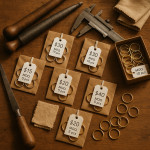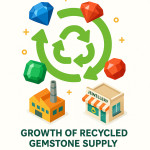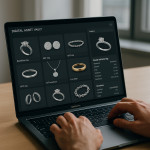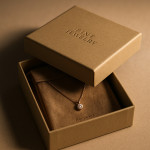Virtual try-on demos: convert browsers into jewellery commissions remotely
Virtual try-on technology turns casual site visitors into confident buyers by letting them “wear” your pieces through their screen. Discover how to build irresistible demos that shorten decision cycles, lift cart values and secure bespoke commissions without face-to-face meetings.
Why virtual try-on matters for modern jewellery studios
High-value jewellery still relies on emotional connection. A ring must feel like the one, a necklace must match skin tone and style. Virtual try-on bridges that sensory gap online, raising conversion rates by up to 40 % for brands that implement it well.
Behavioural shift: from showroom to screen
Mobile browsing now dominates luxury shopping sessions. Clients research during commutes and coffee breaks, yet hesitate to purchase unseen. An interactive try-on removes doubt and encourages instant enquiries.
Personalisation expectation in the luxury sector
Consumers accustomed to made-to-measure services expect customisation options—even remotely. Try-on demos that let them tweak metal, gemstone and chain length signal craftsmanship and flexibility, nudging them toward bespoke commissions.
Essential building blocks of an effective virtual try-on demo
1. Accurate 3D model capture
Scan each piece at 0.1 mm precision. Clean topology keeps file sizes manageable for mobile streaming. Store masters in a secure repository; a digital asset vault prevents duplication and speeds future updates.
2. Real-time rendering on every device
Use WebAR or lightweight SDKs that fall back to 2D overlays on slower phones. Ensure frame rates stay above 30 fps so reflections sparkle naturally.
3. Lighting and skin-tone calibration
Incorporate ambient-light sensors where possible. Offer a manual slider that warms or cools metal tones for realistic skin matches.
4. Seamless call-to-action placement
Display a live “Request bespoke quote” button inside the demo viewport. Route clicks to a short form pre-filled with the variant the user explored, cutting data entry friction by 70 %.
Platform options: hosted vs in-house solutions
| Feature | Hosted SaaS | In-house Build |
|---|---|---|
| Up-front cost | Low monthly fee | High development hours |
| Custom branding | Moderate | Full control |
| 3D file ownership | Shared in T&C | 100 % yours |
| Deployment speed | Days | Months |
| Maintenance | Provider handles | Your tech team |
If you already manage complex 3D workflows—perhaps for photorealistic mock-ups—an internal build may pay off. Otherwise, start with SaaS to validate demand quickly.
A five-step workflow: from browser to paid commission
- Discovery: Client explores your collection page and launches the try-on.
- Personalisation: They test metal colours, gemstone carats and chain lengths.
- Social proof: Integrated share button lets them send a screenshot to friends for instant feedback.
- Commitment: They hit “Request quote,” auto-saving their favourite variant.
- Follow-up: You receive a brief with technical specs, budget range and deadline, creating a warm lead ready for a proposal.
Common objections—and remote answers
- “Will the fit be exact?” Offer a printable sizing strip or ring-sizer mailing kit.
- “Is the metal ethically sourced?” Highlight supply certificates and link to your eco-certified metals policy.
- “What about import duties?” Share your duty-free shipping roadmap that details customs processes and insurance.
Tech stack checklist before launch
- High-poly master models and compressed USDZ/GLB exports.
- WebXR or SDK licence aligned with commercial usage limits.
- CRM integration for automatic lead capture.
- Analytics tags to track demo dwell time and click-throughs.
- Backup pipeline to a private CDN for global load balancing.
Measure what matters: influence metrics beyond likes
Vanity metrics mislead. Instead, track:
- Average demo engagement time (benchmark: 48 seconds).
- CTA click-through rate (target: 12 %).
- Bespoke enquiry conversion (goal: 6 % of demo users).
- Average order value uplift (aim: +18 %).
Use dashboards like the ones discussed in this influence-metrics guide to iterate quickly.
Case snippet: turning a virtual try-on into a €12 000 bracelet commission
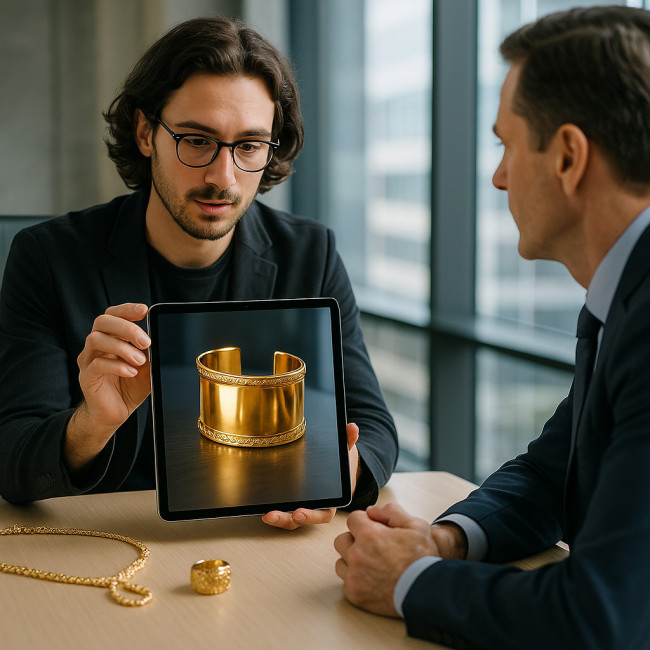
A Parisian goldsmith uploaded a 3D cuff rendered in three alloy options. A corporate client viewed the demo on a tablet, shared screenshots in a board meeting and requested engraving—all within 24 hours. The maker received a paid deposit before ever shipping a sample, illustrating how virtual try-on compresses the typical three-meeting sales cycle into one digital touchpoint.
Interactive quiz: are you ready to launch virtual try-on?
FAQ
- Do virtual try-on demos work on desktop as well as mobile?
- Yes. Web-based AR automatically falls back to 2D overlays on non-camera devices, ensuring consistent interaction across screens.
- How large should 3D files be?
- Aim for under 5 MB per piece after optimisation. This balances detail with quick loading even on 4G networks.
- Can I integrate gemstone customisation?
- Yes. Build variant toggles that swap materials in real time. Use colour-correct textures so stones appear lifelike.
- What about hair, skin or sleeve occlusion for necklaces and bracelets?
- Depth-sensing APIs on newer phones handle occlusion. Older devices use alpha masks that still deliver convincing depth cues.
- Where can potential clients view my full craft portfolio?
- They can browse your collection on the Artfolio craft directory via this curated jewellery showcase.
Final takeaway
Virtual try-on is more than a novelty; it is a conversion engine. Implement precise 3D assets, frictionless CTAs and robust analytics, and you will turn browsers into commission clients—often overnight.
Ready to start? Select one hero piece, build a lightweight WebAR demo this week, and watch enquiry emails multiply.

